CADILLAC ELDORADO 1997 10.G Owners Manual
Manufacturer: CADILLAC, Model Year: 1997, Model line: ELDORADO, Model: CADILLAC ELDORADO 1997 10.GPages: 361, PDF Size: 22.85 MB
Page 101 of 361

Downloaded from www.Manualslib.com manuals search engine The Rainsense system can be activated by turning the
wiper stalk to one of the five sensitivity levels within the
AUTO DELAY
area. The AUTO DELAY position
closest to
OW is the lowest sensitivity setting. This
allows more water to collect on the windshield between
wipes. Rotating the stalk away from you to the other
AUTO DELAY settings increases the sensitivity of the
system and frequency
of wipes. A single wipe will occur
each time you
turn the wiper stalk to a higher sensitivity
level.
An initial wipe occurs when you turn the ignition
on as a reminder that Rainsense
is active. The
windshield wipers also remain in a “high
park” position,
even when
the ignition is turned off.
The Rainsense wipers operate in a delay mode as well as
a continuous low or high speed depending on the amount
of moisture and the sensitivity level. The MIST and
“wash” cycles operate as normal and are not affected
by the Rainsense hnction.
It is important to note that the Rainsense wiping feature
(AUTO DELAY) can be overridden at any time by
manually changing the wiper control to EO or
HI
speed.
Note that
if you ever need to replace the windshield,
make sure it
is Rainsense compatible.
~~ ~ ~~~ ~
In freezing weather, don’t use your washer until
the windshield
is warmed, Otherwise the washer
fluid
can form ice on the windshield, blocking
your vision,
Press and hold the PUSH paddle to wash the windshield.
Release the paddle when you have enough fluid.
The
wipers will clear the windshield and either stop or return
to your preset speed.
LOW WASHER
FLUID will be displayed on the DIC
when the washer fluid reaches a low level.
Driving without washer fluid can be dangerous.
A bad
mud splash can block your vision and you could hit
another vehicle or
go off the road. Check the washer
fluid level often.
-3
Page 102 of 361
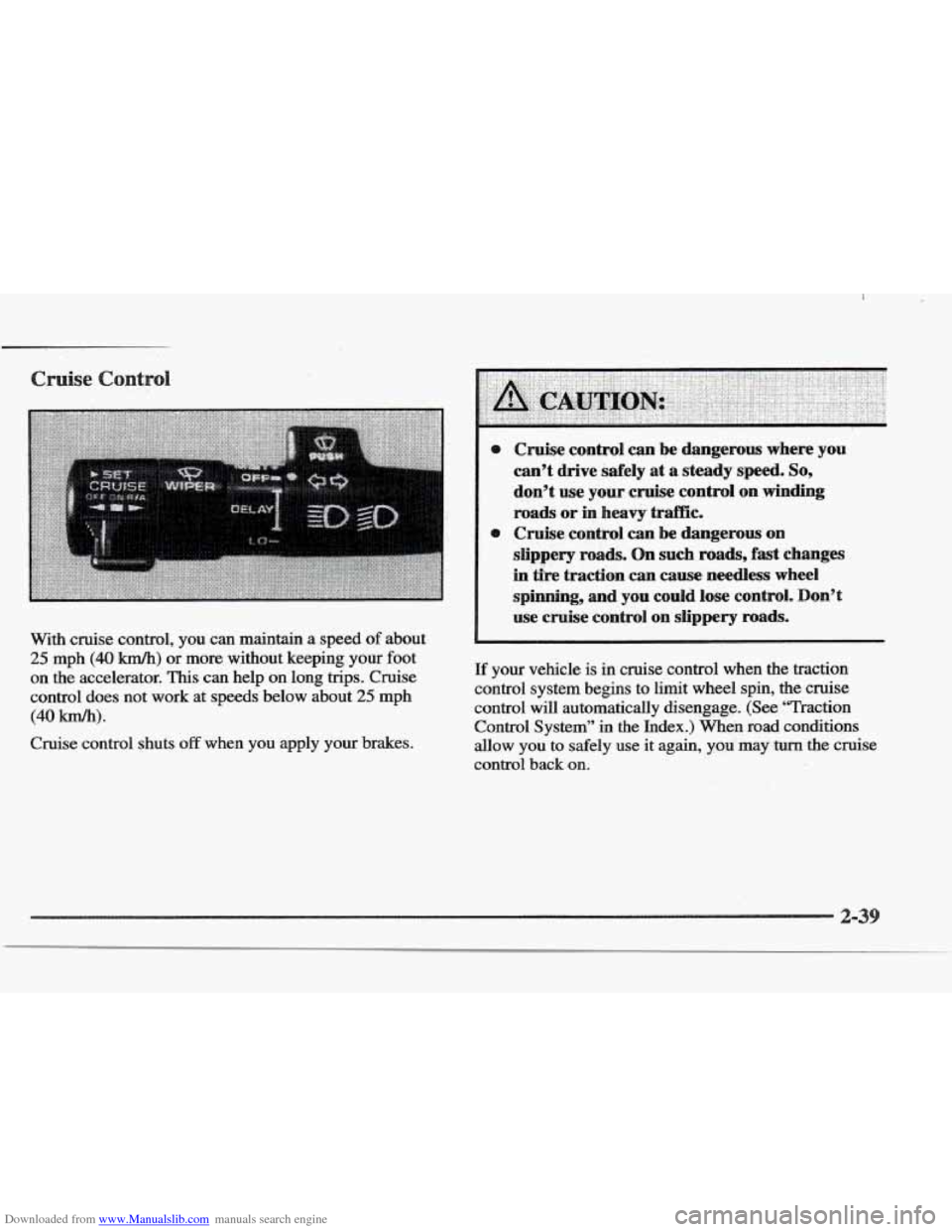
Downloaded from www.Manualslib.com manuals search engine With cruise control, you can maintain a speed of about
25 mph (40 km/h) or more, without keeping your foot
on the accelerator. This can help on long trips. Cruise
control does not
work at speeds below about 25 mph
(40 lun/h).
Cruise control shuts off when you apply your brakes.
I use cruise control on slippery roads.
If your vehicle is in cruise control when the traction
control system begins to limit wheel spin,
the cruise
control will automatically disengage.
(See ‘Traction
Control System” in the Index.)
When road conditions
allow you to safely use it again,
yoti may turn the cruise
control back on.
Page 103 of 361
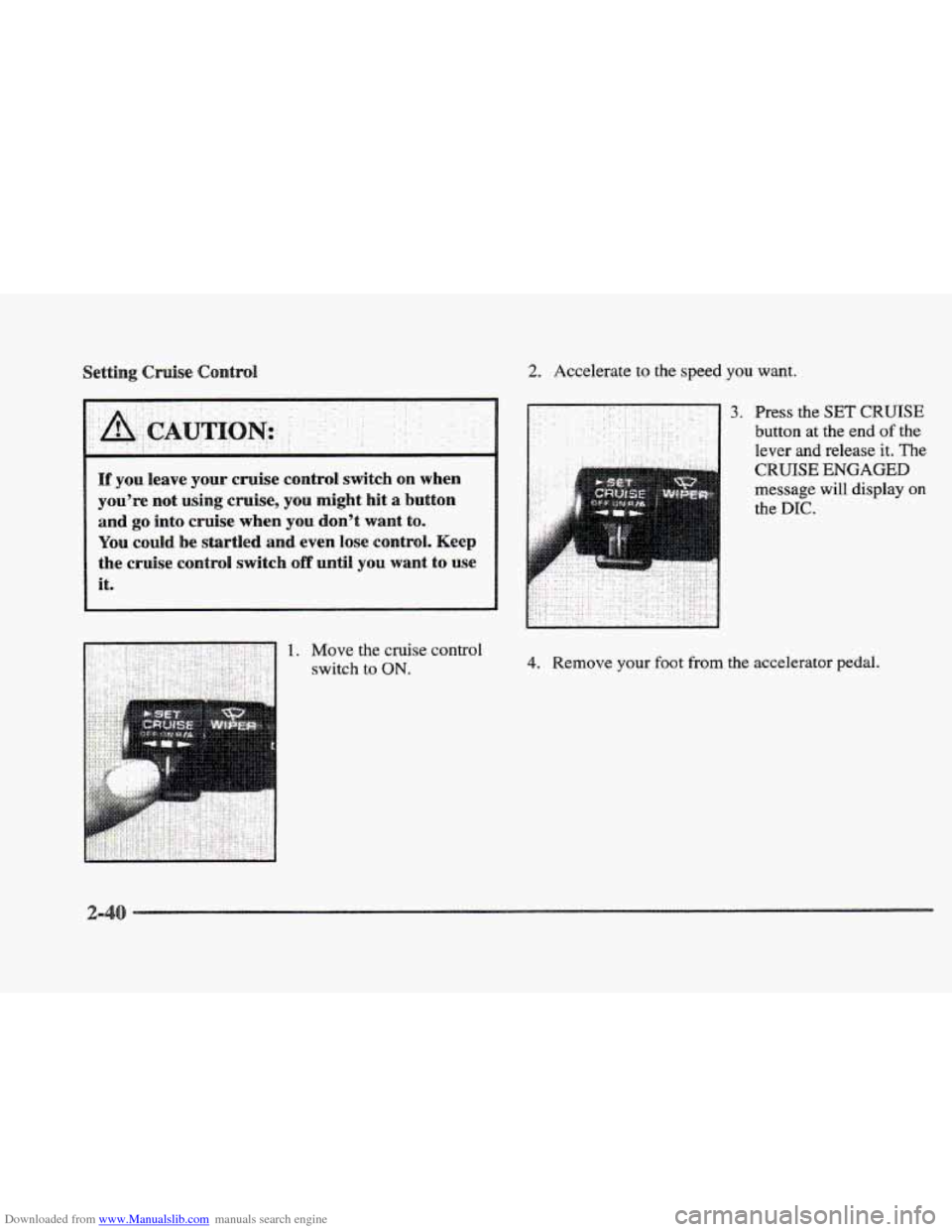
Downloaded from www.Manualslib.com manuals search engine 2. Accelerate to the speed you want.
l[f you leave your cruise contrd switch on when
you’re not using cruise, you might hit
a button
and go into cruise whew YOU don’t want to.
YQU cdd be startled and even lose control. Keep
the cruise
contrdi switch off until YOU want to use
it.
3. Fress the SET CRUISE
button at the end of the
lever and release it. The
CRUISE ENGAGED
message will display on
the DIC.
4. Remove your foot from the accelerator pedal.
Page 104 of 361
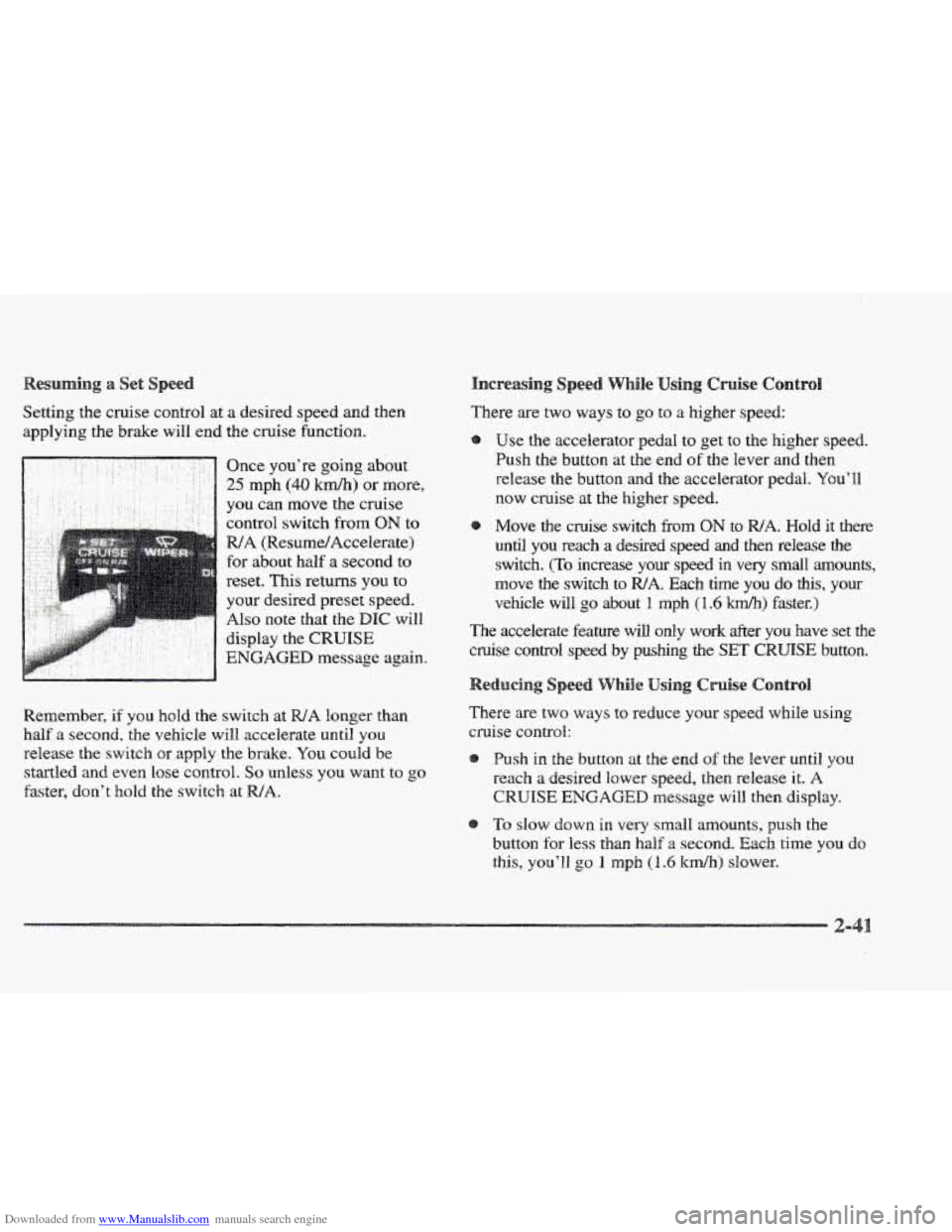
Downloaded from www.Manualslib.com manuals search engine Setting the cruise control at a desired speed and then
applying the brake will end the cruise function.
. .. .. .
. -. ..
.. .. .. : - .: -' Once you're going about .. .. ' ' ' 25 mph (40 krn/h) or more,
Remember,
if you hold the switch at WA longer than
half
a second, the vehicle will accelerate until you
release the switch or apply the brake. You could be
startled and even lose control.
So unless you want to go
faster, don't hold the switch at WA.
There are two ways to go to a higher speed:
Use
the accelerator pedal to get to the higher speed.
Push the button at the end of the lever and then
release
the button and the accelerator pedal. You'll
now cruise at the higher speed.
Move the cruise switch
from ON to WA. Hold it there
until
you reach a desired speed and then release the
switch. (To increase your speed in very small amounts,
move the switch to
WA. Each time you do this, your
vehicle will
go about 1 mph (1.6 'km/lr) faster.)
The accelerate feature will only work after you have set the
cruise control speed
by pushing the SET CRUISE button.
There are two ways to reduce your speed while using
cruise control:
Push in the button at
the end of the lever until you
reach
a desired lower speed, then release it. A
CRUISE ENGAGED message will then display.
To slow down in very small amounts, push the
button
for less than half a second. Each time you do
this, you'21 go 1 rnph (I .6 ltdh) slower.
2-
Page 105 of 361
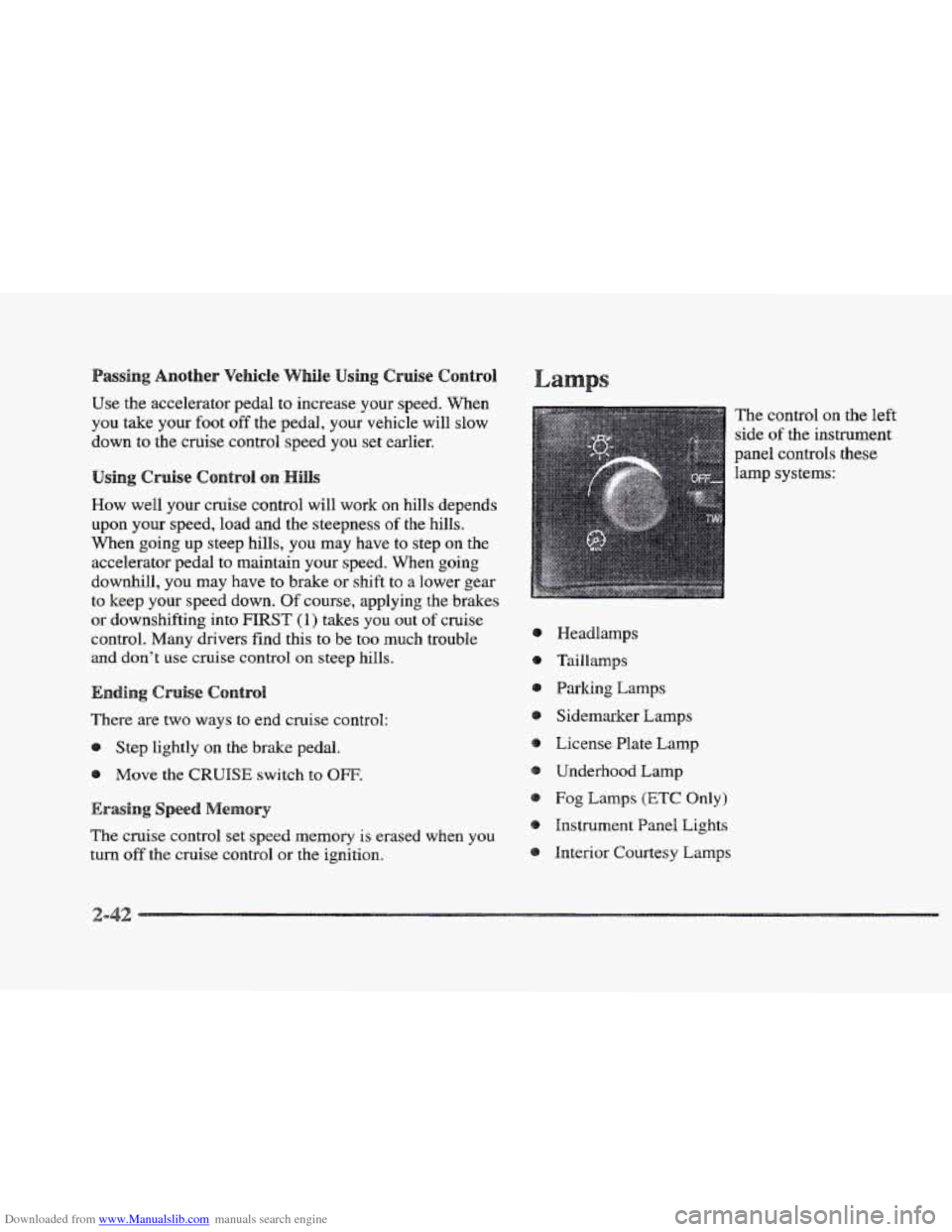
Downloaded from www.Manualslib.com manuals search engine asshg Another Vehicle While Using Cruise Control
Use the accelerator pedal to increase your speed. When
you take your foot off the pedal, your vehicle will slow
down to the cruise control speed you set earlier.
Using Cruise Control on
How well your cruise control will work on hills depends
upon your speed, load and the steepness
of the hills.
When going up steep hills, you may have to step on the
accelerator pedal to maintain your speed. When going
downhill, you may have to brake or shift to
a lower gear
to keep your speed down.
Of course, applying the brakes
or downshifting into
FIRST (1) takes you out of cruise
control. Many drivers find this to be too much trouble
and don’t use
cruise control on steep hills.
Ending Cruise Conn&ro11
There are two ways to end cruise control:
Step lightly on the brake pedal.
Move
the CRUISE switch to OW.
Erasing Spee
The cruise control set speed memory is erased when you
turn off the cruise control or the ignition.
s
Headlamps
Taillamps
Parking Lamps
Sidemaker Lamps
License Plate
Lamp
Underhood Lamp
Fog Lamps (ETC Only)
Instrument Panel Lights
Interior Courtesy Lamps The control
on the left
side
of the instrument
panel controls
these
lamp systems:
Page 106 of 361
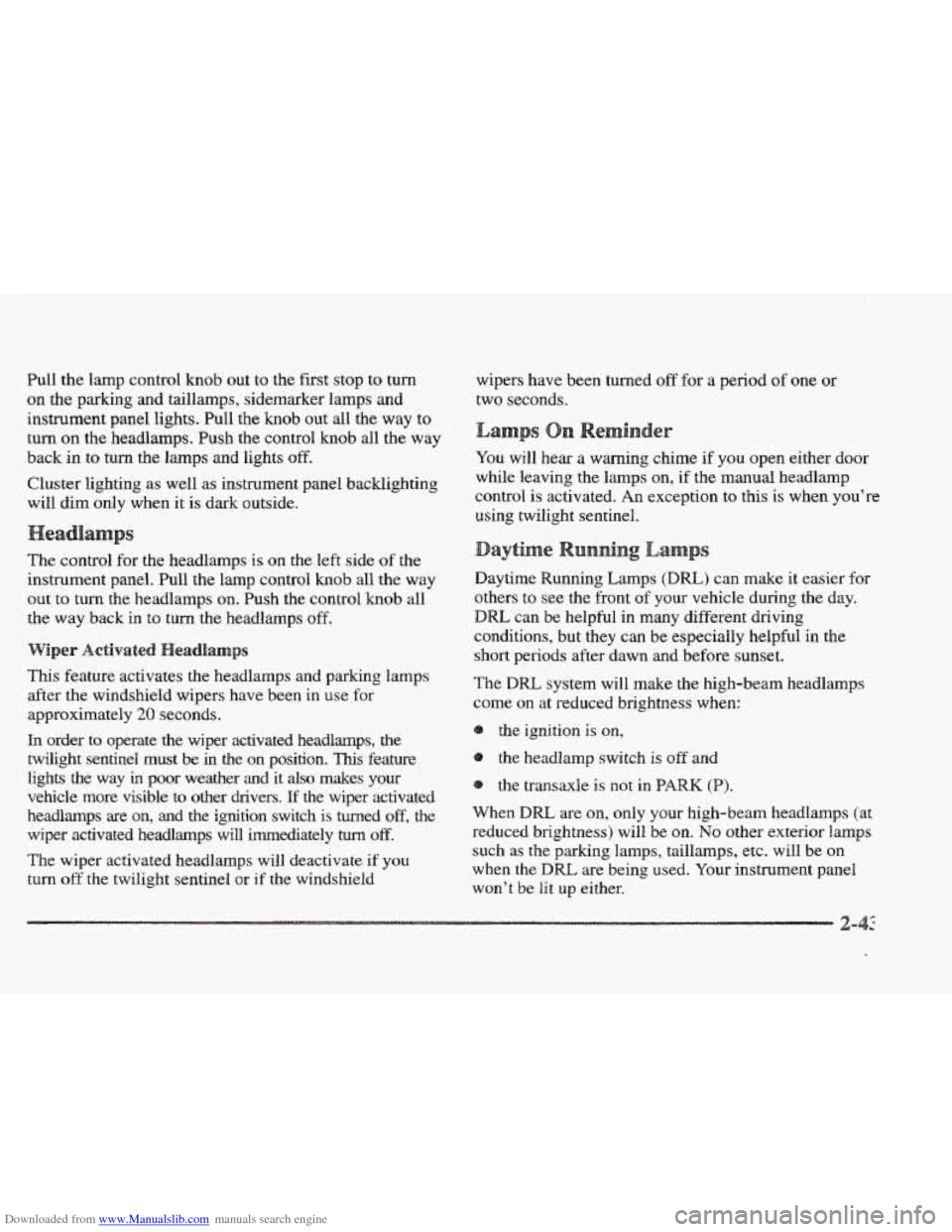
Downloaded from www.Manualslib.com manuals search engine Full the lamp control knob out to the first stop to turn
on the parking and taillamps, sidemarker lamps and
instrument panel lights. Pull the knob out
all the way to
turn on the headlamps. Push the control knob all the way
back in
to turn the lamps and lights off.
Cluster lighting as well as instrument panel backlighting
will dim only when it
is dark outside.
The control for the headlamps
is on the left side of the
instrument panel. Pull the lamp control
knob all the way
out to turn the headlamps on. Push the control knob all
the way back
in to turn the headlamps off.
This feature activates the headlamps and parlung lamps
after the windshield wipers have been in use for
approximately
20 seconds.
In order to operate the wiper activated headlamps, the
twilight sentinel must
be in the on position. This feature
lights the way
in poor weather and it also makes your
vehicle more visible
to other dnvers. If the wiper activated
headlamps are on, and the i,gpition switch
is turned off, the
wiper activated headlamps will immediately turn off.
The wiper activated headlamps will deactivate if you
turn
OR the twilight sentinel or if the windshield wipers
have been turned
off for a period of one or
two seconds.
You will hear a warning chime if you open either door
while leaving
the lamps on, if the manual headlamp
control is activated.
An exception to this is when you’re
using twilight sentinel.
Daytime Running Lamps
(DRE) can make it easier for
others to see the front of your vehicle during
the day.
DIU can be helpful in many different driving
conditions, but
they can be especially helpful in the
short periods after dawn and before sunset.
The DIU system will make the high-beam headlamps
come
on at reduced brightness when:
the ignition
is on,
the headlamp switch is off and
the transaxle
is not in PARK (P).
When DRE are on, only your high-beam headlamps (at
reduced brightness) will be
on. No other exterior lamps
such as the parking lamps, taillamps, etc. will be on
when
the DlRE are being used. Your instrument panel
won’t
be lit up either.
Page 107 of 361
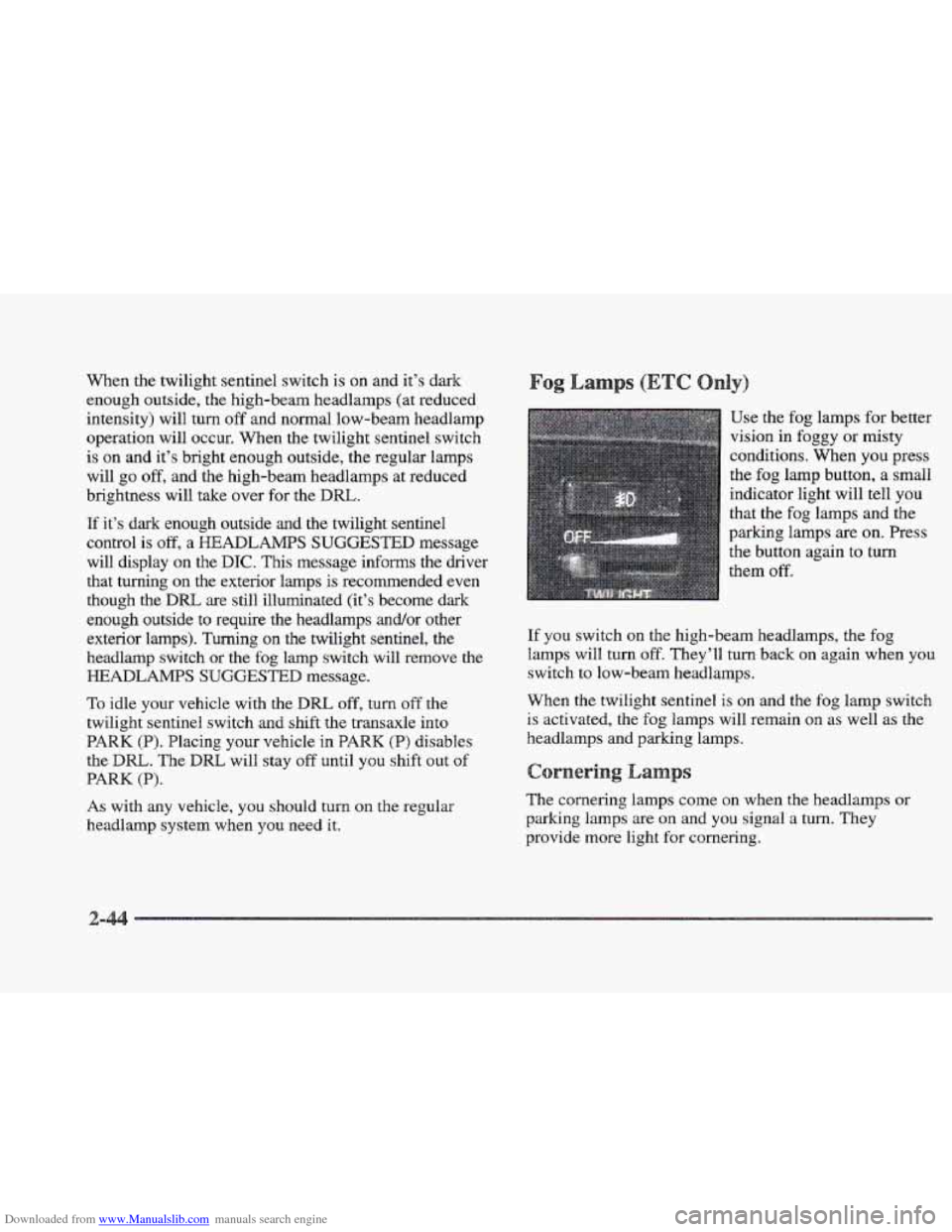
Downloaded from www.Manualslib.com manuals search engine When the twilight sentinel switch is on and it’s dark
enough outside, the high-beam headlamps (at reduced
intensity) will
turn off and normal low-beam headlamp
operation will occur.
When the twilight sentinel switch
is
on and it’s bright enough outside, the regular lamps
will go
off, and the high-beam headlamps at reduced
brightness will
take over for the DRL.
If it’s dark enough outside and the twilight sentinel
control
is off, a I!DMDLMS SUGGESTED message
will display on the
DTC. This message informs the driver
that turning on
the exterior lamps is recommended even
though the DIU are still illuminated (it’s become dark
enough outside to require the headlamps and/or other
exterior lamps). Turning
on the twilight sentinel, the
headlamp switch or
the fog lamp switch will remove the
HEADLAMPS SUGGESTED message.
To idle your vehicle with the DWL off, turn off the
twilight sentinel
switch and shift the transaxle into
PARK (P). Placing your vehicle in PARK (P) disables
the Dm. The DRL will stay off until you shift out of
PARK (P).
As with any vehicle, you should turn on the regular
headlamp
system when you need it.
Use the fog lamps for better
vision
in foggy or misty
conditions. When you press
the fog lamp button, a small
indicator light will tell you
that
the fog lamps and the
parking lamps are on. Press
the button again to
turn
them off.
If you switch on the high-beam headlamps, the fog
lamps will turn off. They’ll
turn back on again when you
switch to low-beam headlamps.
?%%en
the twilight sentinel is on and the fog lamp switch
is activated, the fog lamps will remain on as well as the
headlamps and parking lamps.
s
The cornering lamps come on when the headlamps or
parking
lamps are on and you signal a turn. They
provide more light
for cornering.
Page 108 of 361
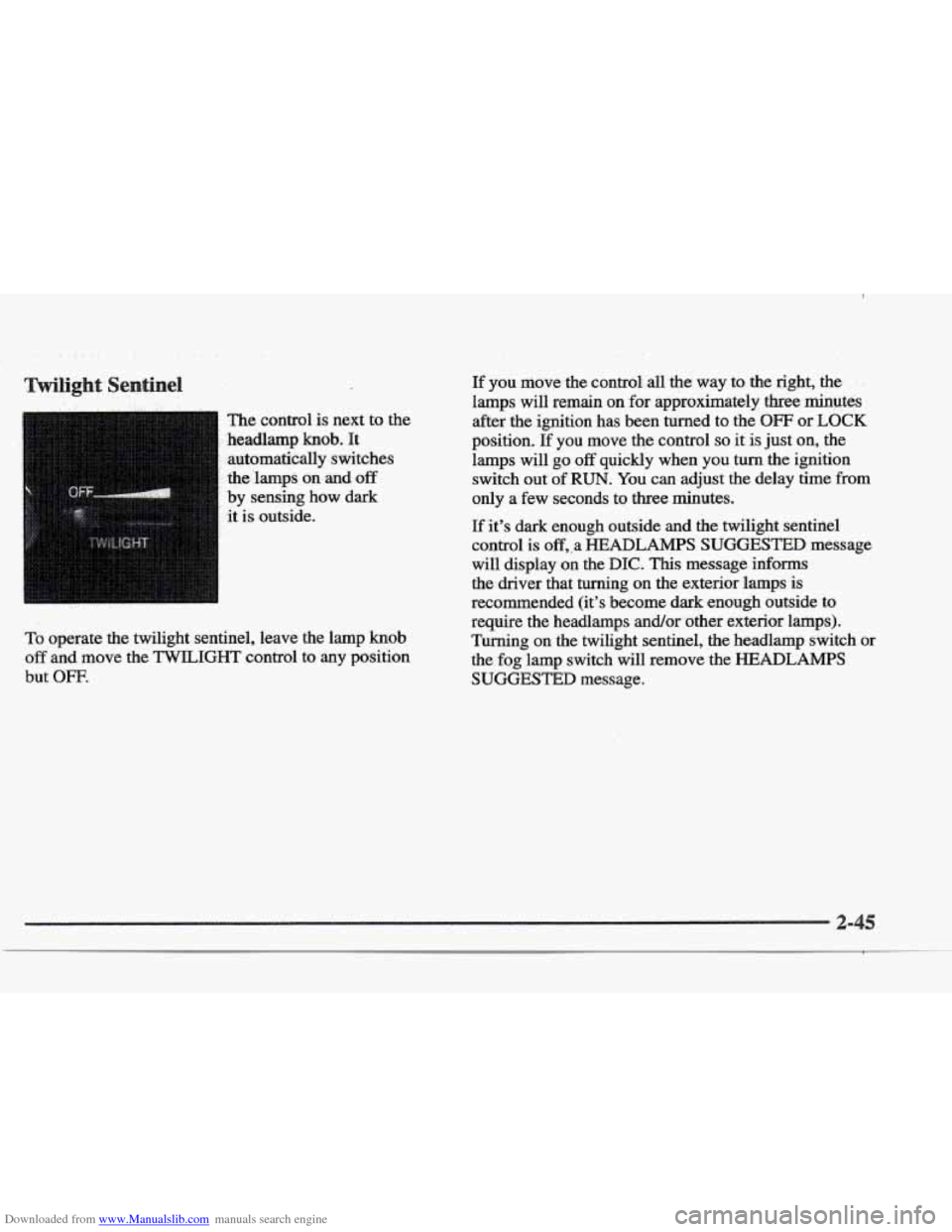
Downloaded from www.Manualslib.com manuals search engine light Sentinel
.. . ..
.. The control is next to the
.headlamp
knob. It
automatically switches
the’lamps
on and off
by sensing how dark
it
is outside.
To operate the twilight sentinel, leave the lamp knob
off and move the TWILIGHT control to any position
but
OFF.
If you move: the control: all the way to the right, the , .
lamps will remain on for approximately three rninutes
after the ignition has been turned to the OFF or
LOCK
position. If you move the control so it is just on, the
lamps will go
off quickly when you turn the ignition
switch out of
RUN. You can adjust the delay time from
only a few seconds to three minutes.
If it’s dark enough outside and the twilight sentinel
control
is off,,a HEADLAMPS SUGGESTED message
will display on the
DIC. This message informs
the driver that turning
on the exterior lamps is
recommended (it’s become dark enough outside
to
require the headlamps and/or other exterior lamps).
Turning on the twilight sentinel, the headlamp switch
or
the fog lamp switch will remove the HEADLAMPS
SUGGESTED message.
Page 109 of 361
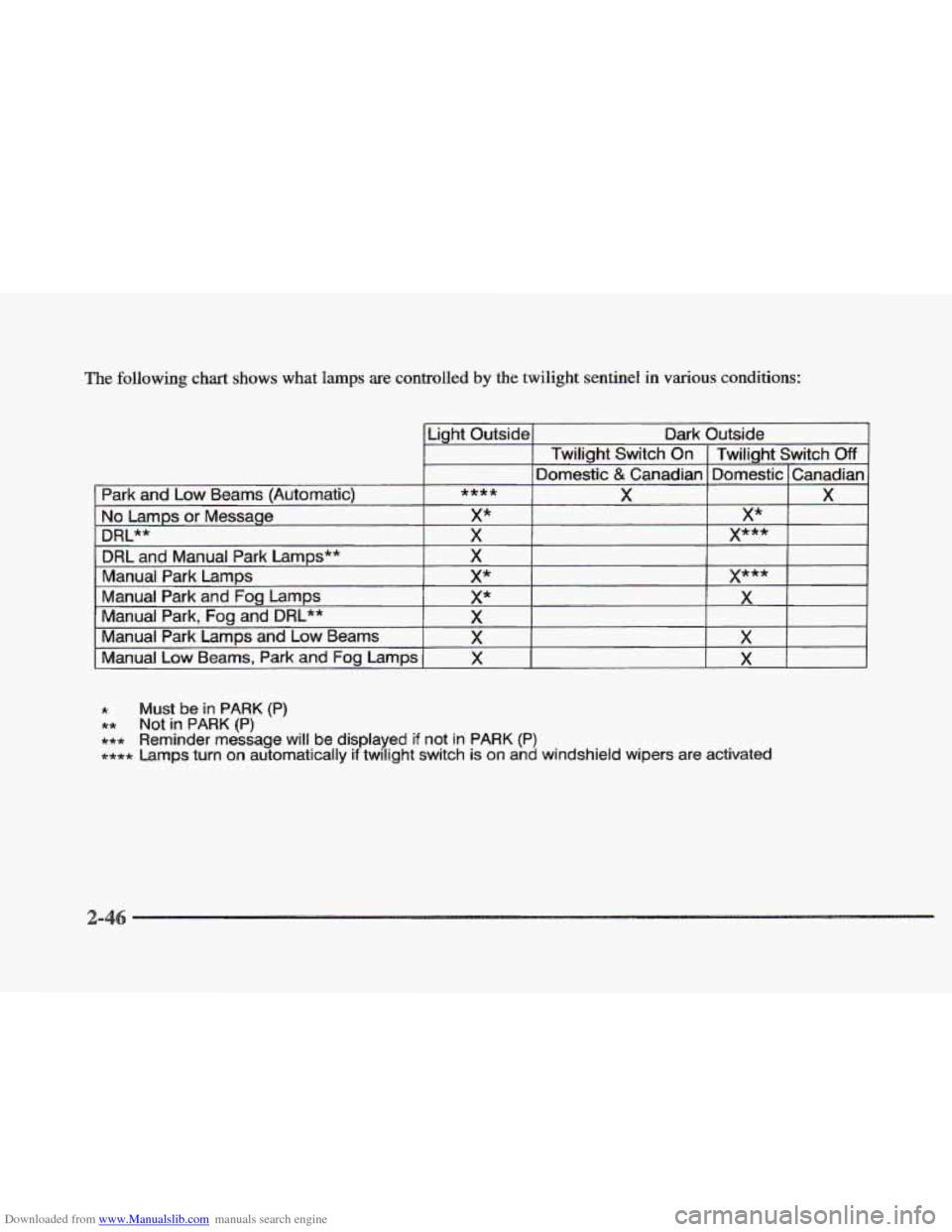
Downloaded from www.Manualslib.com manuals search engine The following chart shows what lamps are controlled by the twilight sentinel in various conditions:
* Must be in PARK (P)
** Not in PARK (P)
+*+ Reminder message will be displayed if not in PARK (P)
**** Lamps turn on automatically if twilight switch is on and windshield wipers are activated
Page 110 of 361
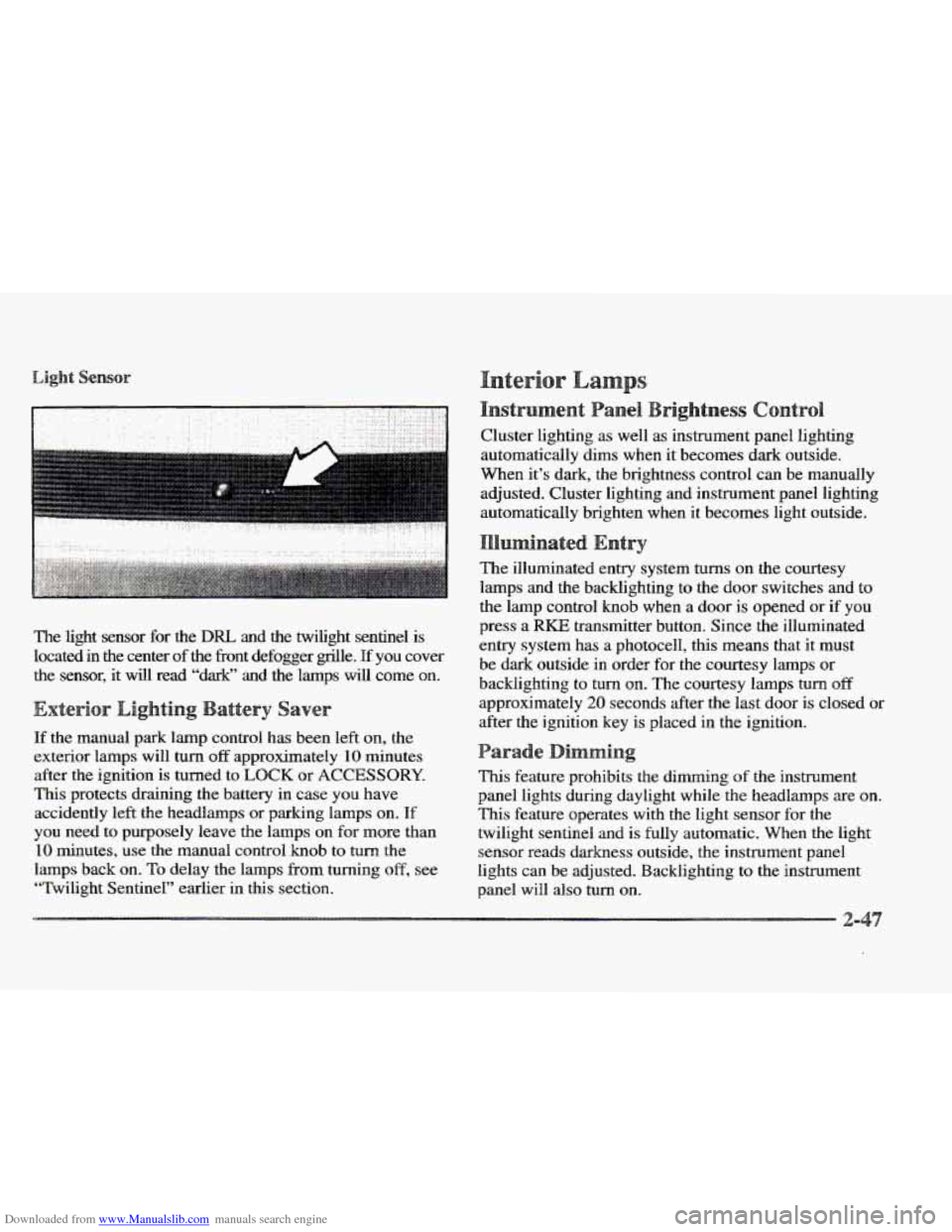
Downloaded from www.Manualslib.com manuals search engine The light sensor for the DRL and the twilight sentinel is
located in the center of
the fiont defogger grrlle. pf you cover
the sensor, it will read “dark”
and the lamps will come on.
If the manual park lamp control has been left on, the
exterior lamps will
turn off approximately 10 minutes
after the ignition
is turned to LOCK or ACCESSORY.
This protects draining the battery in case you have
accidently
left the headlamps or parkmg lamps on. If
you need to purposely leave the Imps on for more than
10 minutes, use the manual control knob to turn the
lamps back on.
To delay the lamps from turning off, see
“Twilight Sentinel” earlier in this section. Cluster lighting
as well
as instrument panel lighting
automatically dims when it becomes dark outside.
When it’s dark,
the brightness control can be manually
adjusted. Cluster lighting and instrument panel lighting
automatically brighten when it becomes light outside.
The illuminated entry system
turns on the courtesy
lamps and the backlighting to the door switches and
to
the lamp contr~l knob when a door is opened or if you
press a RKE transmitter button. Since the illuminated
entry system has
a photocell, this means that it must
be dark outside
in order for the courtesy lamps or
backlighting
to turn on. The courtesy lamps turn off
approximately 20 seconds after the last door is closed or
after the ignition key
is placed in the ignition.
This feature prohibits the dimming of the instrument
panel lights during daylight while
the headlamps are on.
This feature operates with the light sensor for the
twilight sentinel and is fully automatic. When the light
sensor reads darkness outside,
the instrument panel
lights can
be adjusted. Backlighting to the instrument
panel will
also turn on.